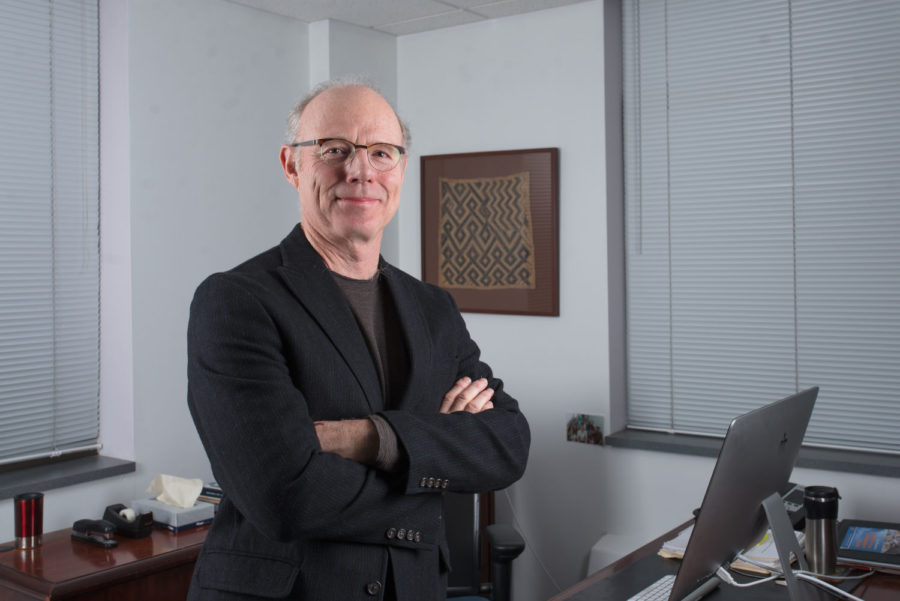30 years of change through the eyes of professors
February 18, 2015
A lot can change in 30 years.
In 1984, Grainger Library wasn’t standing, Chief Illiniwek was dancing on Memorial Stadium’s field, and Unofficial St. Patrick’s Day was not yet a University tradition. Certain aspects of the University and its students have come and gone these past three decades.
Thomas Bassett, however, has remained.
As the professor of geography and geographic information science looks back on the early days of his career, he‘s lists some notable changes of his own. Throughout his time, he’s seen the University through the eyes of both an administrator and a professor, and he’s taught hundreds of students in lecture halls year after year.
“(Today), the student body is more diverse; (there are) a lot more minority students and international students,” Bassett said. “(This makes) a lot more interesting conversations in the classroom. Someone from a different background sees things differently.”
Get The Daily Illini in your inbox!
There have also been changes in technologies, as MacBook Pros and PowerPoint have replaced notebooks and overhead projectors.
“Technology in the classroom made teaching a lot easier,” Bassett said. “Thirty years ago, I had three different medias: live projector, video projector and overhead projector; now, with PowerPoint, it’s so much easier.”
But it’s not just the students and the tactics that have changed; it’s also the very area that Bassett specializes in: geography and information science.
“The strategy of trying to use examples that link students to the global south has evolved and become more important, as globalization has accelerated in the past 30 years,” Bassett said. “Factories in the Midwest have shut down and gone overseas. The world and our relationship to people is changing. People recognize now that we are connected to the wider world.”
The lessons may have changed, but the purpose, however, has not. Bassett has always longed to show his students the importance of global awareness.
“We tend to see ourselves disconnected in what’s going on in Sub-Saharan Africa and Southeast Asia, but we’re intimately connected with these people and these regions by what we eat, what we wear, what we consume,” Bassett said. “What has been consistent is my interest in radical thinking and challenging assumptions about the world. I try to develop empathy in my students for people who live in seemingly distant lands. I try to show they’re connected to us. One of my interests is challenging those received ideas and exposing students to alternative ways of thinking.”
But Bassett isn’t the only professor who’s seen the progression over the years. Since 1983, Diane Koenker, a professor of history in Russian, East European and Eurasian studies, has noticed some alternations of her own.
“Students seem to expect not having to work as hard in their courses as they did 30 years ago; they have a harder time managing the reading and assignment loads,” Koenker said. “Students are (also) stretched more thin than they were 30 years ago. It seems to me that students are working jobs outside of the classroom.”
Koenker has also seen the introduction of new technologies that haven’t positively affected her classroom.
“Email and other kinds of electronics have changed things a lot. It used to be that you would print out copies of your syllabus and that was the communication about the course. Now, there are other ways to communicate,” Koenker said. “It’s made things a lot easier, but the downside is that students are less likely to come to office hours than they used to. Email is a very convenient way to have brief questions answered.”
According to Janice Juraska, a professor in psychology since 1986, these new technologies are impacting the way students learn.
“They don’t learn quite as well, partly because of the electronics,” Juraska said. “It’s easy to think you know it when you passively look at pictures (on a PowerPoint).”
But when Bassett, Koenker and Juraska look back on the past, they return with fears for the future, as the University of Illinois receives considerably less state funding in recent years.
“I think these are troubled times for higher education coming up, because of changing attitudes of the population of the state,” Koenker said. “I think this university — all universities — must fight back against the disrespect for learning. We have to work really hard to convince the society at large why it’s so important to preserve academic freedom, to teach people not just how to get a job in business but become better human beings. Without (knowledge), we would be in the swamp. Knowledge is what makes us function.”
If budget cuts are in the near future, Bassett is concerned that the University will value the STEM programs more than the humanities and arts.
“I’m concerned that the social science and humanities are going to be perhaps less supported because of emphasis on practical skills and jobs. (The University) tends to have a flow of resources toward the STEM disciplines, but we need to put a strong emphasis on the global arts and sciences,” Bassett said. “(A person who) understands culture, can speak another language, can write well and is creative is a well-rounded, educated individual. It’s an ongoing battle to support liberal arts and sciences education.”
But before worrying too much about the future, Bassett focuses on the reasons why he has returned to the classroom year after year.
“Getting published in the best journals, working with graduate students and seeing them become professionals, getting evaluations back that say (my course was) life changing, that’s rewarding,” Bassett said. “I enjoy teaching.”
Sarah can be reached at [email protected]







